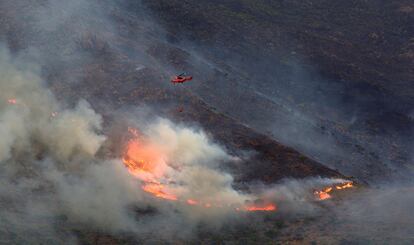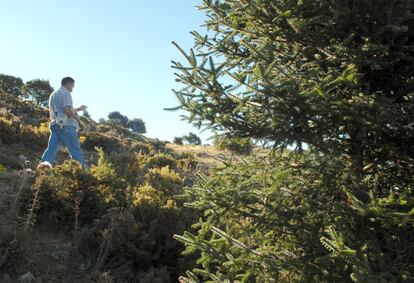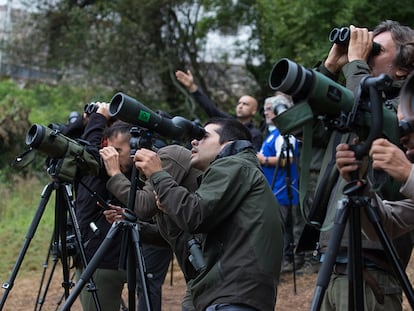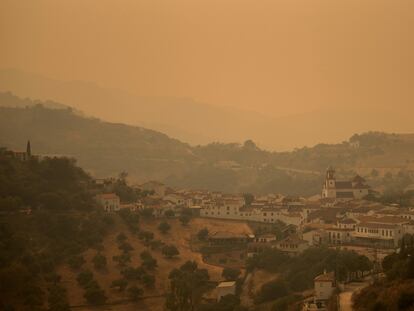Rain helps bring massive blaze in southern Spain under control
Authorities report, however, that the fire is not yet completely extinguished. Conservationists are concerned about the effect on plant and animal life and say the area should have greater protection
Authorities in southern Spain said on Tuesday that a large wildfire that has been raging for six days in Málaga province is finally under control.
After burning through 10,000 hectares of forest land, forcing the evacuation of 3,000 people and claiming one life, the blaze in Sierra Bermeja was contained thanks to rainfall on Monday night.
“The rain that’s been coming down for hours has been the best ally of the intense and admirable work of the fire crews. Level 0 is being activated. A complex period lies ahead until [the fire] is completely extinguished,” said Andalusian premier Juanma Moreno in a message on Twitter early Tuesday morning.
Around a thousand firefighters and 260 members of an emergency military unit had finally made some progress against the flames on Monday, a day after the fire’s perimeter doubled in size to 85 kilometers and split into two fronts.

On Tuesday morning, residents of the mountain village of Genalguacil were told they could return to their homes. Evacuees from five other villages in the valley of Genal had gone home the day before. Residents of Estepona and Benahavís returned on Sunday.
Described last week by a regional official as “a hungry monster,” the blaze is considered one of the most complex ever seen in southern Spain due to its ability to grow quickly and create towering pyrocumulus clouds that can spew embers and start new spot fires.
Erratic winds and the rugged terrain compounded the difficulties for fire crews dealing with a so-called “sixth-generation fire,” which feeds off extremely dry fuel and generates more heat than it would with damp fuel. Climate change is being blamed for long spells of dry weather that create this kind of super-burning tinder.
Fir forests

Environmentalists had been worrying that the wildfire would reach an area filled with a rare fir species, Abies pinsapo, that only grows in parts of southern Spain. Flames did enter the natural space known as Reales de Sierra Bermeja, consuming 148 hectares (around 10% of the land) and burning a few outlying specimens. But the core forest of firs was still untouched on Tuesday.
The Spanish fir is a relic from the past and grows in a few isolated mountain areas of Andalusia. Although it can survive icy temperatures, it does not grow back after a fire, making it particularly vulnerable to blazes like the one in Sierra Bermeja, which conservationists have been following with mounting concern.
Andrés Pérez Latorre, a professor of plant biology at Málaga University, said that none of this would have happened if the area had enjoyed greater legal protection. “It should have been included inside the National Park of Sierra de las Nieves [which was officially created this summer] because that makes it mandatory to draft fire-protection plans and there would have been more surveillance.”
Felipe Román, a biologist and member of the green group Ecologists in Action, agreed. “Sierra Bermeja has been left entirely to its fate; protection from the Andalusian government is only on paper, because there have never been any resources.”
English version by Susana Urra.
Tu suscripción se está usando en otro dispositivo
¿Quieres añadir otro usuario a tu suscripción?
Si continúas leyendo en este dispositivo, no se podrá leer en el otro.
FlechaTu suscripción se está usando en otro dispositivo y solo puedes acceder a EL PAÍS desde un dispositivo a la vez.
Si quieres compartir tu cuenta, cambia tu suscripción a la modalidad Premium, así podrás añadir otro usuario. Cada uno accederá con su propia cuenta de email, lo que os permitirá personalizar vuestra experiencia en EL PAÍS.
¿Tienes una suscripción de empresa? Accede aquí para contratar más cuentas.
En el caso de no saber quién está usando tu cuenta, te recomendamos cambiar tu contraseña aquí.
Si decides continuar compartiendo tu cuenta, este mensaje se mostrará en tu dispositivo y en el de la otra persona que está usando tu cuenta de forma indefinida, afectando a tu experiencia de lectura. Puedes consultar aquí los términos y condiciones de la suscripción digital.











































